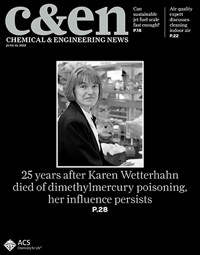Advertisement
Grab your lab coat. Let's get started
Welcome!
Welcome!
Create an account below to get 6 C&EN articles per month, receive newsletters and more - all free.
It seems this is your first time logging in online. Please enter the following information to continue.
As an ACS member you automatically get access to this site. All we need is few more details to create your reading experience.
Not you? Sign in with a different account.
Not you? Sign in with a different account.
ERROR 1
ERROR 1
ERROR 2
ERROR 2
ERROR 2
ERROR 2
ERROR 2
Password and Confirm password must match.
If you have an ACS member number, please enter it here so we can link this account to your membership. (optional)
ERROR 2
ACS values your privacy. By submitting your information, you are gaining access to C&EN and subscribing to our weekly newsletter. We use the information you provide to make your reading experience better, and we will never sell your data to third party members.
Safety
Early Azide Explosion
November 9, 2009
| A version of this story appeared in
Volume 87, Issue 45
Steven V. Ley's letter reminded me of a similar accident that occurred in the late 1940s at a company where I worked as a control chemist (C&EN, June 8, page 4). Although I was not a witness, I seem to remember that the chemical operator was adding sodium azide to a reactor. The process had been in trial use for six months without a glitch or difficulty.
It was midmorning, and an approved crew composed of personnel from research, pilot plant, the safety department, and others had gathered around the open reactor to approve the process when the batch exploded. Seven employees were killed, and others were badly injured. Just as Sheldon Crane reported in his earlier letter, the cause of the explosion was unknown (C&EN, April 13, page 2; June 8, page 4; and July 13, page 2).
I remarked at the time that the cause of the explosion must have been wet methanol, the solvent in the reactor. In my department, we used Karl Fischer reagent to detect water in methanol. We made the reagent in the control laboratory attached to manufacturing by using a standard cylinder of SO2 that was safely locked in place. Our safety engineer, a Navy veteran, was nicknamed "red tag" because he was a stickler for safety in the process. Karl Fischer reagent was standardized at the beginning of every shift as the first job of the shift because the reagent deteriorates with time.
I have always suspected the control chemist was so busy cleaning up the laboratory before the inspection that he forgot to restandardize the Karl Fischer reagent and passed the methanol as being anhydrous. Even an unopened bottle of reagent-grade methanol could be suspect if it has not been tested for moisture before being used. Like metallic sodium, sodium azide and magnesium nitride are unforgiving when added to wet methanol.
Because of labor shortages during World War II, most of the control chemists where I worked were hired after they graduated from high school. I was one of the first college graduates to be hired and quickly rose to group nine on the company pay scale; research hired their chemists with master's degrees at the group-five level and paid them poorly, knowing that after several years they would go back to graduate school.
College—oops—university chemistry laboratories are some of the most dangerous places on campus. I hope that chemistry department heads read this letter.
Robert Seibert
Boerne, Texas




Join the conversation
Contact the reporter
Submit a Letter to the Editor for publication
Engage with us on Twitter